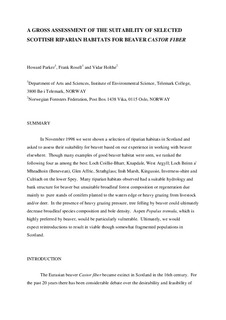| dc.description.abstract | In November 1998 we were shown a selection of riparian habitats in Scotland and asked to assess their suitability for beaver based on our experience in working with beaver elsewhere. Though many examples of good beaver habitat were seen, we ranked the following four as among the best: Loch Coillie-Bharr, Knapdale, West Argyll; Loch Beinn a' Mheadhoin (Benevean), Glen Affric, Strathglass; Insh Marsh, Kingussie, Inverness-shire and Culriach on the lower Spey. Many riparian habitats observed had a suitable hydrology and bank structure for beaver but unsuitable broadleaf forest composition or regeneration due mainly to pure stands of conifers planted to the waters edge or heavy grazing from livestock and/or deer. In the presence of heavy grazing pressure, tree felling by beaver could ultimately decrease broadleaf species composition and bole density. Aspen Populus tremula, which is highly preferred by beaver, would be particularly vulnerable. Ultimately, we would expect reintroductions to result in viable though somewhat fragmented populations in Scotland. | |
